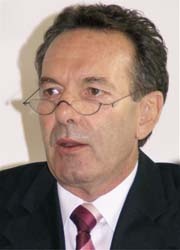Med-tech industry profits are hit by the global financial crisis
The sector is ‘clearly strained’, says Joachim M. Schmitt, Managing Director and Member of Board of the German Medical Technology Association, BVMed, in Berlin. But, the good news is, employment is up and, he adds ‘We are at the beginning of a medical technology revolution’.
‘Overall, healthcare is certainly more panic-proof than, for example, the automobile industry,’ said Joachim Schmitt in a pre-MEDICA discussion with European Hospital.

‘We don’t choose when to become ill and require treatment. However, the arrival of the financial crisis in the real economy will inevitably affect our industry, for instance the credit requirements of start-ups or smaller, innovative companies. The general pressure is also reflected in the results of our current autumn survey. The mood in the medical technology industry has significantly deteriorated compared to last year. Around 37% of companies expect significantly improved results for 2008 compared to the previous year, but 28% of companies expect worse results. The profit situation in the med-tech sector is therefore clearly strained.
‘BVMed companies are particularly looking for more flexibility with the compensation/accounting systems from healthcare politics. If we are to safeguard the financing of statutory health insurance in the long term we need to discuss new ways, such as preferential tax treatment for innovations. If we are to promote medical progress, we need to do this in a more coordinated way and place more emphasis on quality aspects then the medical technology companies will continue to be the drivers of the healthcare economy for the benefits of patients. Even the financial crisis won’t change this.’
Nonetheless, in terms of a global position of German med-tech firms are ‘well placed’, he believes. ‘In the promising fields of medicine technology innovation, Germany is in a good position to introduce new products and procedures to the market due to its high number of well-trained doctors, researchers and engineers and high standards in clinical research. However, there are significant shortcomings in Germany regarding the introduction of innovations into the compensation systems. We are currently working together with the ministries for research, economy and health to improve this situation.
‘The fact that Germany is well-placed is demonstrated by the fact that the med-tech sector keeps creating new jobs despite the increased pressure on prices. According to a survey by BVMed this autumn, 55% of the 220 member companies have created new jobs compared to last year. Just under 30% of companies maintained a stable number of employees. Projected across all the member companies of the association this means that 4,200 jobs were created. The entire sector employs more than 170,000 people in Germany.’
In terms of the value of exhibiting at MEDICA, it is the showcase in which to display the highly innovative and dynamic med-tech industry to the entire world; the companies ‘achieve about a third of their sales volume with products less than three years old,’ he said. ‘On average, the med-tech companies that focus on research invest around 9% of their turnover into research and development. This shows the dynamics of this industry sector, which is reflected by the exhibitors at Medica as well as in the congress programme.’
Joachim Schmitt pointed to the multitude of new technolo-gies in development, including
tissue engineering; new ‘intelligent’ materials; the integration of telemedical applications into treatment procedures; minimally-invasive surgical procedures; neurostimulation methods, and nanotechnology. ‘These technologies are continuously being integrated, which results in highly developed therapies that often break through traditional boundaries and sectors.’
One of the main trends highlighted by Medica, he said, is computerization. ‘It’s taken hold in medical technology because of the importance of information and communication technology. Computer support will significantly increase in image processing, modelling and simulation. Physiological causes of diseases will become increasingly easier to detect with the help of new model-based procedures of biosignal processing. Implants will become more efficient due to improved hardware. Therapy systems, such as those used in dialysis or respiration, will have more intelligent control due to the set-up of model-based control circuits.’
Another trend is e-health, telemedicine and telemonitoring, with developments in the necessary networking, as well as the vision of a European electronic patient file. ‘Data structures are designed in a way that facilitates the largest possible advantage for the patient whilst ensuring data protection. One example is telecardiology, which ensures the best therapy for patients with pacemakers, implanted defibrillators or CRT implants, because their condition can be continuously monitored: if necessary doctors can intervene at short notice and adapt their treatment.’
He also added that miniaturisation is another area of progress, whether through microsystems, nanotechnology or optics. ‘In the future, interventions will be carried out with minimally-invasive surgery ever more frequently,’ he predicted. ‘The key words here are image-guided, catheter-based, endoscopic and stereotactic. Pro-bes have to be precisely navigated through the body and positioned so that detailed diagnosis and therapy can be carried out in situ.
‘All this goes to show that medical technology has a high potential for innovation through the consolidation of different scientific disciplines,’ he pointed out. ‘One thing is clear: The development of medical technology is nowhere near complete with the ending of the 20th century. To the contrary, it is likely that progress will become even more rapid. We are at the beginning of a medical technology revolution.’
18.11.2008











